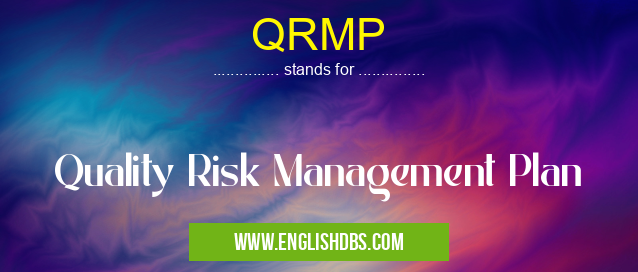What does QRMP mean in MANAGEMENT
QRMP stands for Quality Risk Management Plan. It is a comprehensive document that outlines the systematic process for identifying, assessing, controlling, and mitigating risks that may impact the quality of a product or service. QRMPs are essential for organizations seeking to maintain high standards of quality while minimizing risks and ensuring customer satisfaction.

QRMP meaning in Management in Business
QRMP mostly used in an acronym Management in Category Business that means Quality Risk Management Plan
Shorthand: QRMP,
Full Form: Quality Risk Management Plan
For more information of "Quality Risk Management Plan", see the section below.
» Business » Management
Key Elements of a QRMP
- Risk Identification: Identifying potential risks that could affect the quality of the product or service.
- Risk Assessment: Evaluating the likelihood and severity of identified risks to determine their potential impact.
- Risk Control: Developing and implementing strategies to mitigate or eliminate identified risks.
- Risk Monitoring: Regularly reviewing and updating the QRMP to ensure its effectiveness and address any emerging risks.
- Risk Communication: Sharing risk-related information with stakeholders to facilitate decision-making and foster a risk-aware culture.
Benefits of a QRMP
- Improved Quality: QRMPs help organizations proactively identify and address risks that could impair quality, leading to enhanced product or service outcomes.
- Reduced Costs: By mitigating risks, QRMPs can help prevent costly errors, rework, and customer dissatisfaction.
- Enhanced Compliance: QRMPs demonstrate an organization's commitment to quality and regulatory compliance.
- Increased Customer Satisfaction: A proactive approach to risk management helps ensure the delivery of high-quality products or services, fostering customer loyalty and satisfaction.
Essential Questions and Answers on Quality Risk Management Plan in "BUSINESS»MANAGEMENT"
What is a Quality Risk Management Plan (QRMP)?
A QRMP is a comprehensive document that outlines the processes and procedures for identifying, assessing, and mitigating risks to the quality of a product or service. It ensures that products and services meet regulatory requirements and customer expectations.
Why is a QRMP important?
A QRMP is important because it provides a systematic approach to managing risks that could impact the quality of a product or service. It helps organizations to proactively identify potential risks and develop strategies to mitigate their impact, thereby ensuring that products and services are safe, effective, and meet customer needs.
What are the key elements of a QRMP?
Key elements of a QRMP typically include: risk identification, risk assessment, risk mitigation, risk monitoring, and risk communication. It also includes documentation of the risk management process, including the roles and responsibilities of individuals involved in risk management.
Who is responsible for developing and implementing a QRMP?
The responsibility for developing and implementing a QRMP typically falls on the organization's quality assurance or quality management team. However, it is a collaborative effort that involves individuals from various departments, including production, engineering, regulatory affairs, and sales.
How can a QRMP be used to improve product or service quality?
By proactively identifying and mitigating risks, a QRMP helps to prevent defects, errors, and other quality issues from occurring. It ensures that the organization has a robust quality management system in place, leading to improved product or service quality, increased customer satisfaction, and reduced costs associated with quality failures.
Final Words: A well-developed and effectively implemented QRMP is a crucial tool for organizations seeking to achieve and maintain high standards of quality. By identifying, assessing, and mitigating risks, QRMPs help control potential hazards, improve decision-making, and ultimately enhance customer satisfaction. Organizations committed to quality should consider implementing a comprehensive QRMP to safeguard their products or services and drive continuous improvement.
